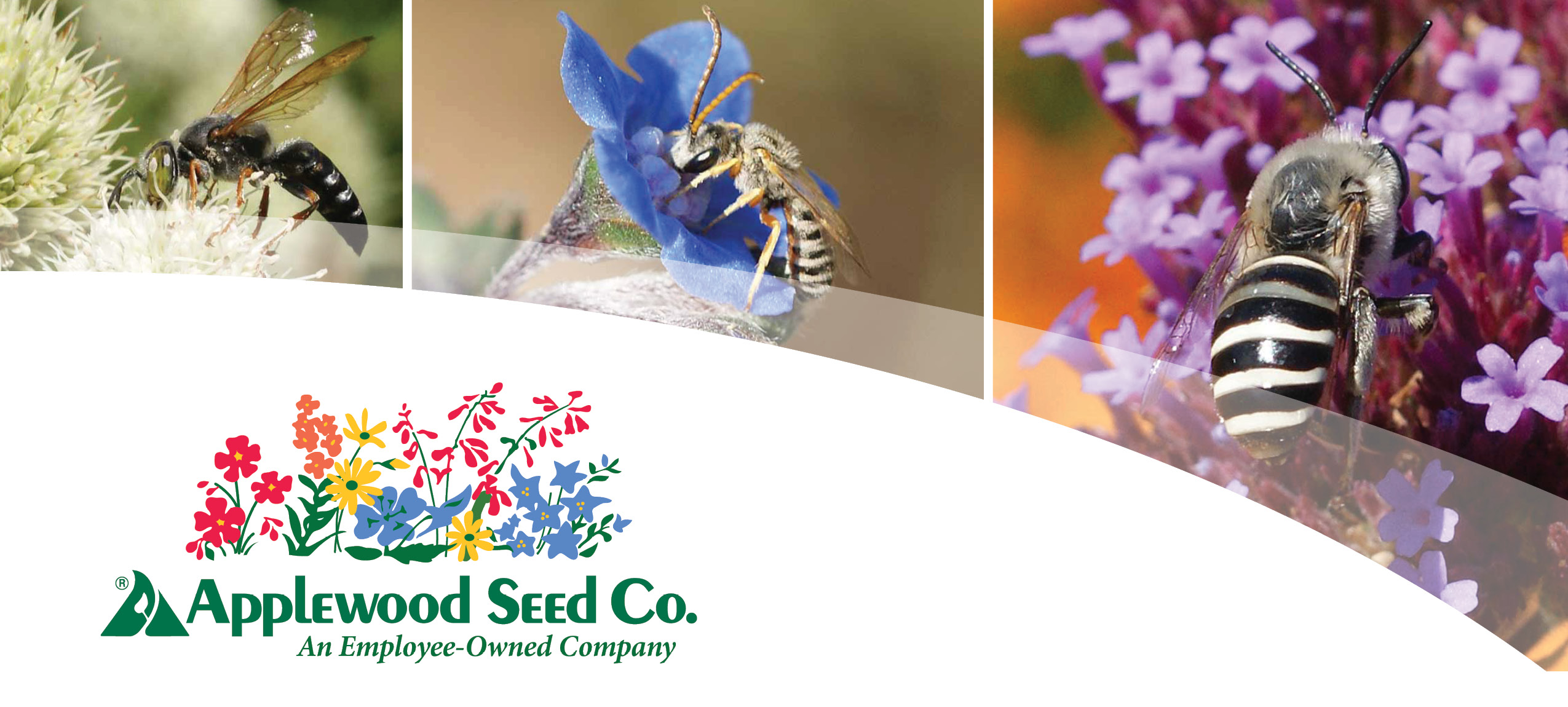
Biodiversity Series on Native Bees
Native Bee Group: Solitary Bees
Welcome to part two of Applewood Seed Company’s in-depth look at our native bees. Today we’ll be focusing on bees that live more solitary lives than their bumblebee cousins. Click here to read about the social lives of native bumblebees in the first part of the biodiversity series.
The European honeybee, which is a non-native species, can be easily mistaken for a native bee. However, there are thousands of unique species of native bees living in North America today. When you see a bee flying casually around your farm or garden, you will probably see a native bee as there are approximately 4,000 unique species of native bees in North America. Some of our native bee species are social bees that live together in colonies, but the vast majority are solitary bees that live on their own.
Native bee species collect nectar and pollen from a range of native and non-native plant varieties which make them generalist foragers and account for nearly 75% of the 4,000 different bee species. The remaining species of bees are specialists that only forage on a few types of native plant species or may be fully dependent on a single plant species. Additionally, there are indications of evolutionary bonds between bees and plants due to the emergence of specialist bees from their nests just as their selected plant species begin to flower.
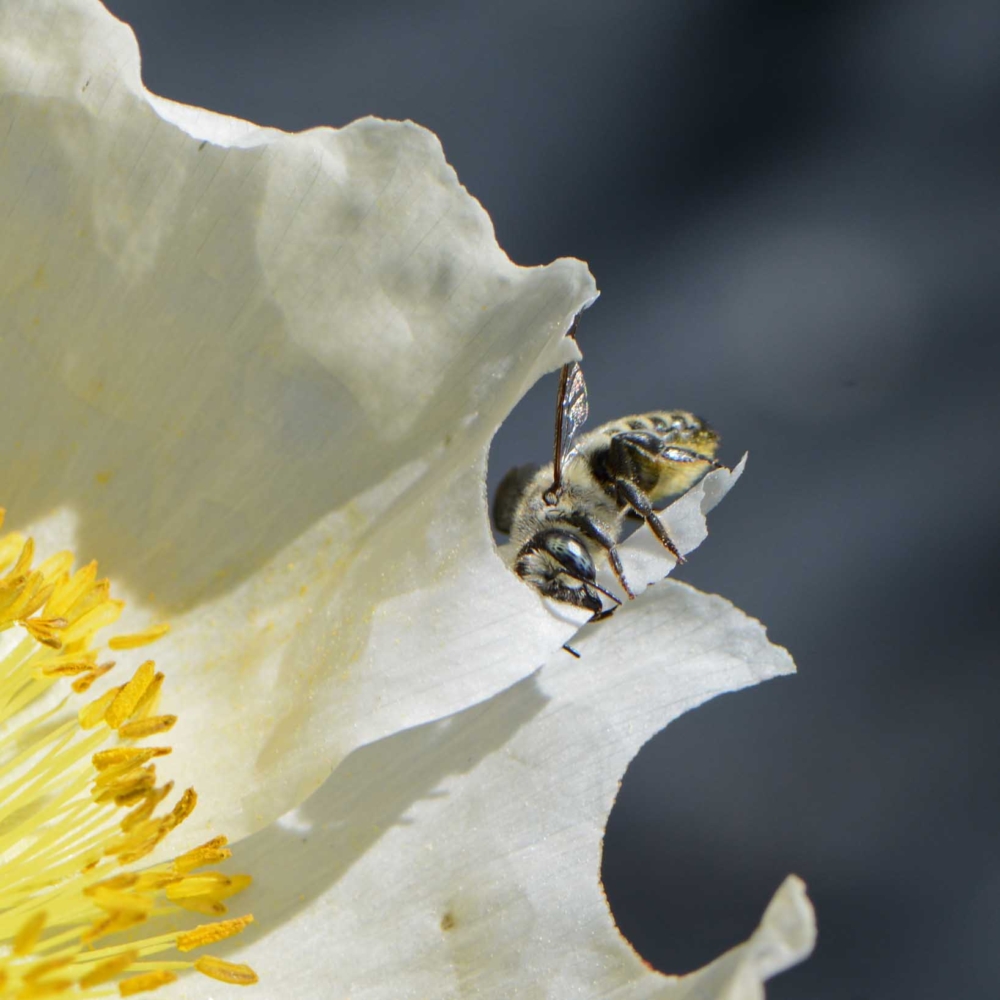
Leafcutter Bee cutting out a piece of petal
Leafcutter Bees, Mason Bees & Allies (Megachilidae Family)
Female bees in this group are easy to spot in the field because they have a pollen brush (abdominal scopa) on the underside of their abdomens, making them very effective pollinators. You will often see them scoot backwards around and into flowers as they collect pollen!
Leafcutter Bees have long tongues and cut out pieces of leaves and petals with their mandibles to use in their nest construction. They are important pollinators of many native wildflowers. In our gardens, they are found frequenting numerous species of flowers: Blue Sage, Blue Vervain, Fleabane Daisy, Englemann Daisy, Golden Aster, Hairy Beardtongue, Lemon Mint, Oregano, Ox-Eye Sunflower, Prairie Aster, Purple Coneflower, Shasta Daisy, Smooth Penstemon, and Yarrow.
Mason Bees use mud for their nest construction and build their nests in holes of wood or hollow twigs.
One group of Mason Bees are the Orchard Bees. As the name implies, they are excellent pollinators of many fruit trees such as apples, plums, pears, almonds, and peaches. Preferred flowers in our gardens include Bigflower Cinquefoil, Blanketflower, Chives, Lewis Flax, and Penstemon.
Carpenter, Long-Horned, Sunflower & Digger Bees (Apidae Family)
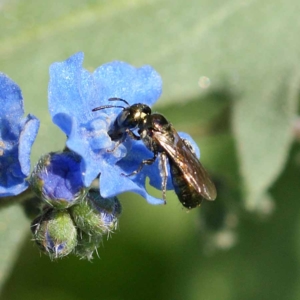
A small Carpenter Bee
Carpenter Bees make their nests by chewing out holes in wood or twigs, which is how they get their name. Small Carpenter Bees have short tongues and are early morning foragers. They like Chinese Forget-Me-Not, Corn Poppy, English Daisy, and Fleabane Daisy. Large Carpenter Bees have long tongues and visit flowers with long corollas.
This family also includes the distinctive Long-horned and Sunflower Bees, whose males have very long antennae (often almost as long as their
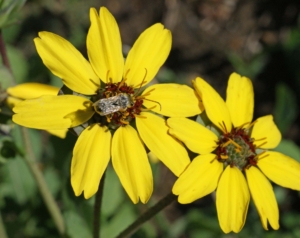
Long-Horned Bee
bodies), and stout females with particularly fluffy scopal hairs on their back legs that often get so full of pollen, they might resemble pantaloons. These bees have long tongues and prefer flowers such as Bergamot, Black-Eyed Susan, Cosmos, Sulphur Cosmos, Clarkia, Hollyhock, Indian Blanket, Globemallow, Ox-Eye Sunflower, Prairie Coneflower, and Wild Sunflower.
Digger Bees build nests in areas of exposed soil on banks, road cuts, or open ground. Some large Anthophora species exhibit a more hovering flight pattern similar to hummingbirds and can be quite inquisitive of anyone roaming “their” flower patch. Digger Bees have long tongues, and flower favorites include Penstemon, Rocky Mountain Beeplant, and Purpletop Vervain.
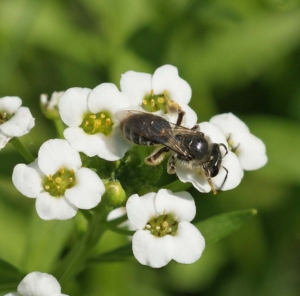
Mining Bee
Mining Bees (Andrenidae Family)
Mining Bees are small to moderate in size, have short tongues, and nest underground, sometimes in aggregations or groups. One of the larger genera, Andrena, is characterized by hairy grooves on the inside margin of their eyes called facial foveae. Many species are active only in the spring or late summer. They pollinate many species of wildflowers, flowering trees, and shrubs. Flowers preferred by mining bees include Basket-of-Gold, Bigflower Cinquefoil, English Daisy, Fleabane Daisy, Golden Alexander, Goldenrod, Lance-Leaved Coreopsis, Prairie Sunflower, and Sweet Alyssum.
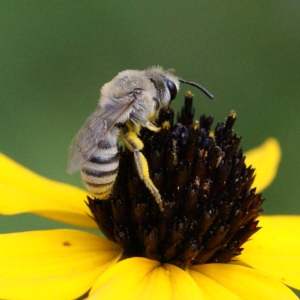
Plasterer Bee
Plasterer Bees & Masked Bees (Colletidae Family)
Plasterer Bees are also called Polyester Bees because they line their nests with a cellophane-like secretion that makes their nests waterproof. They have short tongues and forage on flowers with short nectar access such as Goldenrod, Prairie Aster, Sulphur Flower, and White Upland Aster.
Masked Bees have small, slender bodies and white or yellow markings on their faces. Their bodies are usually black and lack pollen-carrying structures. They carry nectar and pollen in a crop (internal pouch) and regurgitate it upon returning to their nests. These bees nest in stems and twigs, lining the cells with a cellophane-like material. They have very short tongues and like to forage on Bigelow’s Aster, Chinese Forget-Me-Not, Fleabane Daisy, Golden Aster, Lacy Phacelia, and Prairie Aster.
Sweat Bees (Halictidae Family)
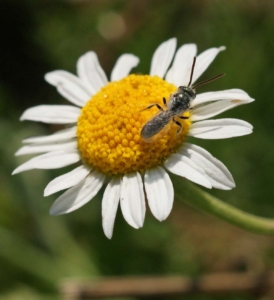
Sweat Bee
These bees get their name from being attracted to sweat on people’s skin. If one lands on you in the garden, not to fear! These tiny bees, like most native
bees, tend to be very placid and do not sting without provoking. They build solitary nests in the ground and have long slender bodies with striped
abdomens. Their colors range from black and brown to brilliant metallic greens and blues. The females have pollen-collecting hairs on their hind legs called scopae. Sweat bees have short tongues and prefer flowers with short nectar access such as Black-Eyed Susan, China Aster, Chinese Forget-Me-Not, Cornflower, Fleabane Daisy, Indian Blanket, Painted Daisy, and Plains Coreopsis.
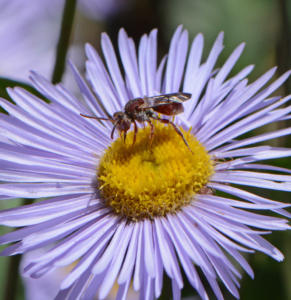
Cuckoo Bee
Cuckoo Bees (Various Bee Families)
Cuckoo Bees are parasites of other bees and may represent as much as 15% of the world’s bee species. They are part of the natural order of things, and if you spot cuckoo bees in your garden, it’s a healthy sign that there is a complex network of bee populations there. Cuckoo bees lay their eggs in the nests of their host species and allow them to provision their young. For this reason, cuckoo bees do not have pollen-carrying structures on their bodies and no nest-making capabilities. They do not have many hairs on their bodies, which makes them easy to confuse with wasps. What hair they do have resembles very short and silvery velveteen in various colors and patterns, including a “smiley face” on the thorax of certain Triepeolus species. They visit flowers for nectar and have been seen on Blanketflower, English Daisy, Lance-Leaved Coreopsis, Ox-Eye Sunflower, Prairie Aster, and Prairie Coneflower.



Applewood Seed Co. Announces Strategic Leadership Changes to Drive Business Growth
Applewood Seed Co., an employee-owned company, the leading supplier and wholesaler of open-pollinated flower seeds in the U.S., proudly announces two pivotal promotions within its leadership team. Mary Gomane has been promoted to Vice President of Sales & Production and Joe Eenigenburg has advanced to the role of Director of Sales & Marketing. These strategic […]
Using Flowers as Nature’s Solution to Water Conservation
In the realm of commercial landscaping, traditional turfgrass lawns still reign as the go-to for public and private projects. However in recent years, the practice of replacing turfgrass with flowers has steadily gained popularity, not only for the aesthetic appeal but specifically for the positive impact on water conservation and cost reduction.